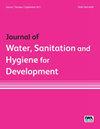埃塞俄比亚获得基本水、环境卫生和个人卫生设施的情况及相关因素:来自人口统计和健康调查的证据
IF 1.4
4区 环境科学与生态学
Q3 WATER RESOURCES
Journal of Water Sanitation and Hygiene for Development
Pub Date : 2022-12-30
DOI:10.2166/washdev.2022.226
引用次数: 0
摘要
在中低收入国家,确保家庭用水、环境卫生和个人卫生设施仍然是一个主要的公共卫生问题。因此,本研究旨在评估埃塞俄比亚家庭获得讲卫生服务的情况及相关因素。在2016年埃塞俄比亚人口健康调查(EDHS)和2019年小型EDHS中,分别对16650户和8663户家庭进行了横断面研究。这些家庭采用分层两阶段整群抽样技术进行选择。进行了多变量逻辑回归分析,以确定与基本讲卫生服务相关的因素。在2016年EDHS和2019年Mini-EDHS中,家庭获得基本供水服务的比例分别为65.2%(95%CI:64.5-65.9%)和68.7%(95%CI:68.01-69.4%)。在2016年的EDHS中,只有25.9%(95%CI:25.2-26.62%)和2019年的Mini-EDHS家庭中,只有27.5%(95%CI:26.34-28.3%)能够获得基本的卫生服务。此外,在2016年EDHS中,只有38%(95%置信区间:37.25-38.8%)的家庭能够获得基本卫生服务。女性户主家庭、城市居民、受过教育、家庭成员≥7岁、有肥皂或洗涤剂、财富指数较高的人最有可能获得基本的讲卫生服务。调查结果总体上表明,有必要采取有效的讲卫生运动干预措施。本文章由计算机程序翻译,如有差异,请以英文原文为准。
Access to basic water, sanitation, and hygiene (WASH) facilities and associated factors in Ethiopia: evidence from demographics and health surveys
In low- and middle-income countries, ensuring water, sanitation, and hygiene (WASH) facilities for households remains a major public health concern. Therefore, this study aimed to assess households’ access to WASH services and associated factors in Ethiopia. A cross-sectional study was conducted among 16,650 and 8,663 households in the 2016 Ethiopian Demographic Health Survey (EDHS) and 2019 Mini-EDHS, respectively. The households were selected using a stratified two-stage cluster sampling technique. Multivariable logistic regression analysis was performed to identify factors associated with basic WASH services. Households’ access to basic water services was 65.2% (95% CI: 64.5–65.9%) and 68.7% (95% CI: 68.01–69.4%) in the 2016 EDHS and 2019 Mini-EDHS, respectively. Only 25.9% (95% CI: 25.2–26.62%) in the 2016 EDHS and 27.5% (95% CI: 26.34–28.3%) in the 2019 Mini-EDHS households had access to basic sanitation services. Moreover, only 38% (95% CI: 37.25–38.8%) of households had access to basic hygiene services in the 2016 EDHS. Female-headed households, urban residents, having education, family members ≥7, presence of soaps or detergents, and having a better wealth index were the most likely to have access to basic WASH services. The findings in general suggest the need for effective WASH interventions.
求助全文
通过发布文献求助,成功后即可免费获取论文全文。
去求助
来源期刊

Journal of Water Sanitation and Hygiene for Development
WATER RESOURCES-
CiteScore
3.10
自引率
11.80%
发文量
58
审稿时长
16 weeks
期刊介绍:
The Journal of Water, Sanitation and Hygiene for Development is a peer-reviewed journal devoted to the dissemination of high-quality information on the science, policy and practice of drinking-water supply, sanitation and hygiene at local, national and international levels.
 求助内容:
求助内容: 应助结果提醒方式:
应助结果提醒方式:


